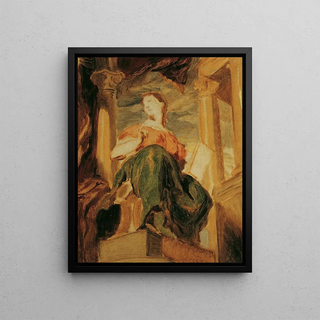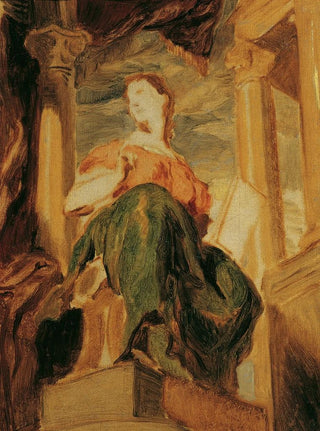Art print | Clio the Muse - Hans Canon


View from behind

Frame (optional)
In the vast panorama of art history, certain artworks stand out for their ability to capture the very essence of inspiration and knowledge. "The Muse Clio - Hans Canon" is a quintessential example. This piece, evoking the muse of history, transports us into a universe where time seems suspended, where every detail tells a story. Clio, often depicted with a book or a scroll of papyrus, embodies not only collective memory but also the importance of history in our understanding of the world. Hans Canon's representation of this muse invites us to explore the intricacies of our past while celebrating art in all its forms.
Style and uniqueness of the work
Hans Canon's work is characterized by impressive technical mastery and a unique stylistic approach. The color palette chosen by the artist, oscillating between warm tones and cooler shades, creates an atmosphere that is both intimate and solemn. The drapery of Clio's garments, rendered with almost photographic precision, testifies to a deep respect for classical traditions while incorporating a touch of modernity. Light also plays a fundamental role in this composition, illuminating the muse's face with an almost divine glow, while shadows add depth and dimension to the overall scene. This blend of realism and idealization makes "The Muse Clio" a piece that transcends a simple portrait to become a true celebration of art and thought.
The artist and his influence
Hans Canon, an artist of Austrian origin, made a name for himself in the 19th-century art scene thanks to his exceptional talent and innovative vision. Raised within a rigorous artistic tradition, he was influenced by the masters of classical painting while seeking to distinguish himself through bold choices and innovative compositions. His work on "The Muse Clio" illustrates not only his technical skill but also his ability to breathe new life into traditional themes. Canon captured the spirit of his time, blending romanticism and realism, and influenced many contemporary and future artists. His contribution to art history is undeniable, and each work he

Matte finish

View from behind

Frame (optional)
In the vast panorama of art history, certain artworks stand out for their ability to capture the very essence of inspiration and knowledge. "The Muse Clio - Hans Canon" is a quintessential example. This piece, evoking the muse of history, transports us into a universe where time seems suspended, where every detail tells a story. Clio, often depicted with a book or a scroll of papyrus, embodies not only collective memory but also the importance of history in our understanding of the world. Hans Canon's representation of this muse invites us to explore the intricacies of our past while celebrating art in all its forms.
Style and uniqueness of the work
Hans Canon's work is characterized by impressive technical mastery and a unique stylistic approach. The color palette chosen by the artist, oscillating between warm tones and cooler shades, creates an atmosphere that is both intimate and solemn. The drapery of Clio's garments, rendered with almost photographic precision, testifies to a deep respect for classical traditions while incorporating a touch of modernity. Light also plays a fundamental role in this composition, illuminating the muse's face with an almost divine glow, while shadows add depth and dimension to the overall scene. This blend of realism and idealization makes "The Muse Clio" a piece that transcends a simple portrait to become a true celebration of art and thought.
The artist and his influence
Hans Canon, an artist of Austrian origin, made a name for himself in the 19th-century art scene thanks to his exceptional talent and innovative vision. Raised within a rigorous artistic tradition, he was influenced by the masters of classical painting while seeking to distinguish himself through bold choices and innovative compositions. His work on "The Muse Clio" illustrates not only his technical skill but also his ability to breathe new life into traditional themes. Canon captured the spirit of his time, blending romanticism and realism, and influenced many contemporary and future artists. His contribution to art history is undeniable, and each work he






